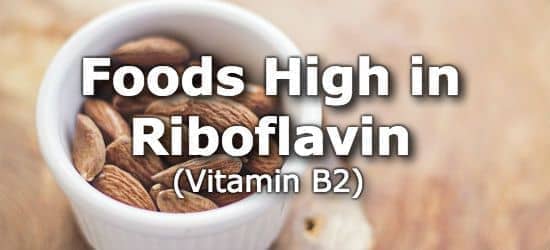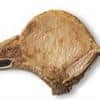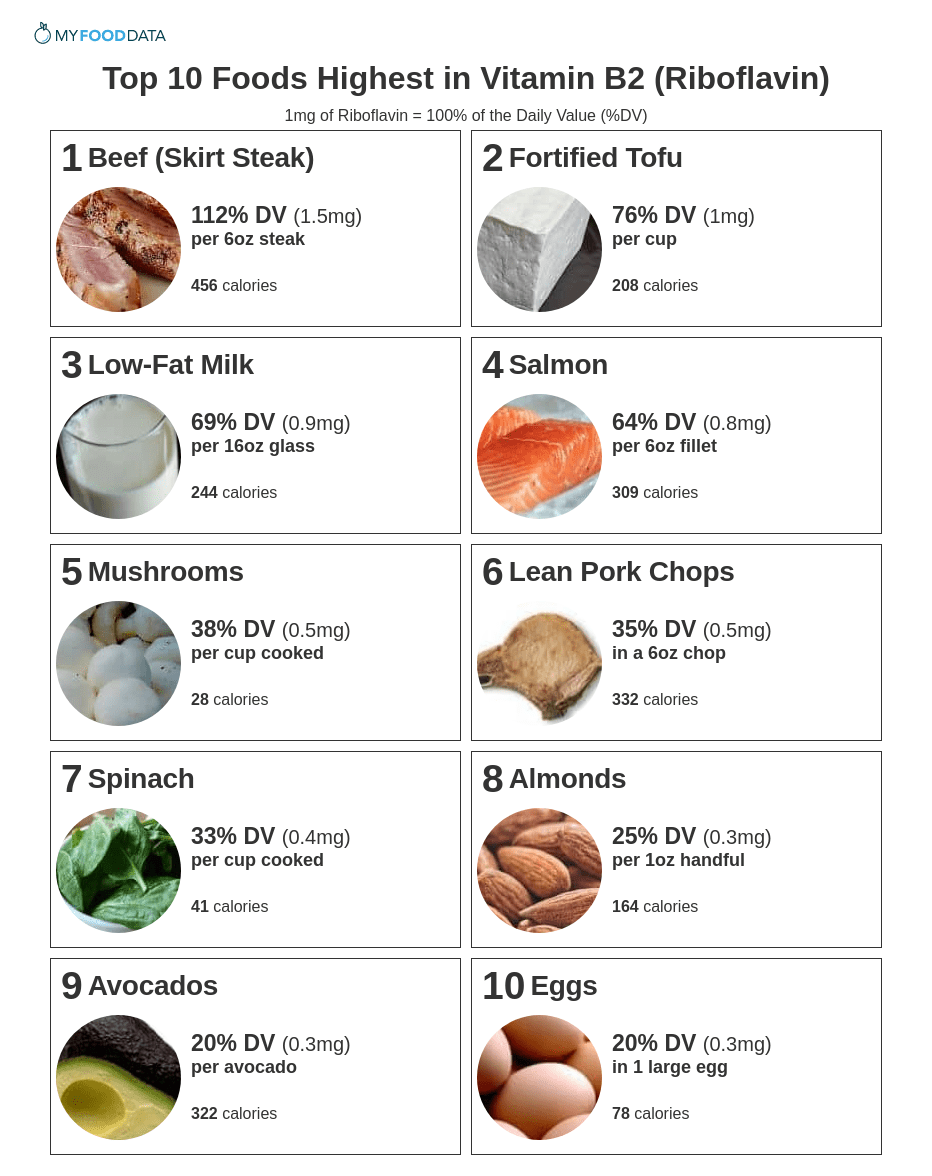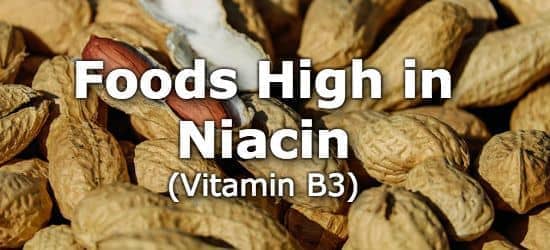Top 10 Foods Highest in Vitamin B2 (Riboflavin)

Vitamin B2, or riboflavin, is an essential vitamin required for energy metabolism, immune system function, and maintenance of healthy skin, and hair. (1)
Riboflavin has also been associated with reducing the risk of cancer, and is believed to have anti-aging effects. (2)
While rare, a deficiency of riboflavin can create health problems that lead to hyperglycemia, hypertension, and diabetes mellitus. (3) Further deficiency can lead to cracking and reddening of the lips, inflammation of the mouth, mouth ulcers, sore throat, and even iron deficiency anemia. (3,4)
Riboflavin is a water-soluble vitamin that is well regulated by the body, thus overdose is rare, and usually only occurs with vitamin B2 injections or supplements.
Foods high in riboflavin include beef, tofu, milk, fish, mushrooms, pork, spinach, almonds, avocados, and eggs. The current daily value (DV) for riboflavin (Vitamin B2) is 1.3mg. (5)
Below is a list of high riboflavin foods sorted by a common serving size. Use the complete nutrient ranking of all foods high in riboflavin to sort by 100 grams or a 200 calorie serving size.
-
 1. Beef (Skirt Steak)
1. Beef (Skirt Steak)
Riboflavin
per 6oz SteakRiboflavin
per 100gRiboflavin
per 200 Calories1.5mg
(112% DV)0.9mg
(66% DV)0.6mg
(49% DV) -
 2. Fortified Tofu
2. Fortified Tofu
Riboflavin
per CupRiboflavin
per 100gRiboflavin
per 200 Calories1mg
(76% DV)0.4mg
(34% DV)1mg
(74% DV)More Soy Products High in Riboflavin
- 79% DV in a 16oz glass of soymilk
- 46% DV in 1 cup of tempeh
- 38% DV in 1 cup of green soybeans
See all beans high in riboflavin.
-
 3. Low-Fat Milk
3. Low-Fat Milk
Riboflavin
per 16oz GlassRiboflavin
per 100gRiboflavin
per 200 Calories0.9mg
(69% DV)0.2mg
(14% DV)0.7mg
(57% DV)More Dairy High in Riboflavin
- 44% DV in 1 cup of non-fat yogurt
- 32% DV in 1 cup of buttermilk
- 22% DV in 4oz of low-fat cottage cheese
See more dairy high in riboflavin.
-
 4. Salmon
4. Salmon
Riboflavin
per 6oz FilletRiboflavin
per 100gRiboflavin
per 200 Calories0.8mg
(64% DV)0.5mg
(37% DV)0.5mg
(41% DV)More Fish and Seafood High in Riboflavin
- 48% DV in 20 small clams
- 40% DV in a 6oz tuna fillet
- 29% DV in 3oz of oysters
See all fish and seafood high in riboflavin.
-
 5. Mushrooms
5. Mushrooms
Riboflavin
per Cup CookedRiboflavin
per 100gRiboflavin
per 200 Calories0.5mg
(38% DV)0.5mg
(36% DV)3.6mg
(274% DV)More Mushrooms High in Riboflavin
- 38% DV in 1 cup of portabella mushrooms
- 33% DV in 1 cup of crimini (chestnut) mushrooms
- 23% DV in 1 cup of oyster mushrooms
See all vegetables high in riboflavin.
-
 6. Lean Pork Chops
6. Lean Pork Chops
Riboflavin
in a 6oz ChopRiboflavin
per 100gRiboflavin
per 200 Calories0.5mg
(35% DV)0.3mg
(21% DV)0.3mg
(21% DV)More Pork Products High in Riboflavin
- 36% DV in 1 cup of lean roast ham
- 35% DV in a rack of country style ribs
- 25% DV in 3oz of pork tenderloin
See all meats high in riboflavin.
-
 7. Spinach
7. Spinach
Riboflavin
per Cup CookedRiboflavin
per 100gRiboflavin
per 200 Calories0.4mg
(33% DV)0.2mg
(18% DV)2.1mg
(158% DV)More Vegetables High in Riboflavin
- 32% DV in 1 cup of beet greens
- 19% DV in 1 cup of asparagus
- 18% DV in 1 cup of peas
See all vegetables high in riboflavin.
-
 8. Almonds
8. Almonds
Riboflavin
per 1oz HandfulRiboflavin
per 100gRiboflavin
per 200 Calories0.3mg
(25% DV)1.1mg
(88% DV)0.4mg
(30% DV)More Nuts and Seeds High in Riboflavin
- 11% DV in 10 chestnuts
- 11% DV in 1 cup of coconut water
- 8% DV in 1oz of dried sunflower seeds
See all nuts and seeds high in riboflavin.
-
9. Avocados
Riboflavin
per AvocadoRiboflavin
per 100gRiboflavin
per 200 Calories0.3mg
(20% DV)0.1mg
(10% DV)0.2mg
(13% DV)More Fruits High in Riboflavin
- 8% DV in 1 cup of bananas
- 8% DV in 1 cup of grapes
- 6% DV in 1 cup of navel oranges
See all fruits high in riboflavin.
-
 10. Eggs
10. Eggs
Riboflavin
in 1 Large EggRiboflavin
per 100gRiboflavin
per 200 Calories0.3mg
(20% DV)0.5mg
(39% DV)0.7mg
(51% DV)- 54% DV in 1 cup of chopped hard-boiled eggs
Printable One Page Sheet

Riboflavin (B2) Requirements By Age and Gender
The recommended daily allowance (RDA) for riboflavin (Vitamin B2) ranges from 0.5mg to 1.3mg per day. The daily value for vitamin B2 is 1.3mg per day. (5)
| Life Stage | RDA |
|---|---|
| Infants* | |
| 0-6 months old | 0.3mg |
| 7-12 months old | 0.4mg |
| Children | |
| 1-3 years old | 0.5mg |
| 4-8 years old | 0.6mg |
| Males | |
| 9-13 years old | 0.9mg |
| 14-18 years old | 1.3mg |
| 19-50 years old | 1.3mg |
| 50+ years old | 1.3mg |
| Females | |
| 9-13 years old | 0.9mg |
| 14-18 years old | 1mg |
| 19-50 years old | 1.1mg |
| 50+ years old | 1.1mg |
| Pregnancy | |
| 14-18 years old | 1.4mg |
| 18+ years old | 1.4mg |
| Lactation | |
| 14-18 years old | 1.6mg |
| 18+ years old | 1.6mg |
Source: Dietary Reference Intakes for Riboflavin.
Other Vitamin B Foods
About the Data
Data for the curated food lists comes from the USDA Food Data Central Repository.
You can check our data against the USDA by clicking the (Source) link at the bottom of each food listing.
Note: When checking data please be sure the serving sizes are the same. In the rare case you find any difference, please contact us and we will fix it right away.
About Nutrient Targets
Setting targets can provide a guide to healthy eating.
Some of the most popular targets include:- Daily Value (%DV) - The daily value (%DV) is a general guideline for consumption that will prevent deficiency of a particular nutrient in most people. The %DV refers to the percentage of an amount that\'s found in a single serving of a food. It also accounts for absorption factors. It is set by the U.S. FDA.
- Recommended Dietary Allowance (%RDA) - The RDA sets an average daily dietary intake level that is sufficient to meet the nutrient requirements of nearly all (97.5%) healthy individuals. It\'s more specific than the daily value, and varies by age and gender. The RDA is set by the US National Institutes of Health.
- Reference Dietary Intake (%RDI) -The reference dietary intake is similar to the recommended daily allowance, but is specific to age and gender. The RDI for amino acids is set by the U.N. World Health Organization.
- Adequate Intake (%AI) - This value is primarily used in reference to omega-3 and omega-6 fats. The Adequate Intake is set by the U.S. Institute of Medicine. Because there is less evidence to determine the ideal targets for consumption of these nutrients, the specific amount is considered to be less reliable. Using the term Adequate Intake, rather than one of the other terms, helps to emphasize that the ideal intake of that particular nutrient has not yet been scientifically determined.
See the Guide to Recommended Daily Intakes for more information.
Want to set your own targets? Sign up for an account and set custom targets in the daily food log.From the Nutrient Ranking Tool
Use the ranking tool links below to select foods and create your own food list to share or print.
- Foods High in Riboflavin (B2)
- Foods Low in Riboflavin (B2)
- Vegetables High in Riboflavin (B2)
- Fruits High in Riboflavin (B2)
- Vegetarian Foods High in Riboflavin (B2)
- Nuts High in Riboflavin (B2)
- Grains High in Riboflavin (B2)
- Beans High in Riboflavin (B2)
- Dairy High in Riboflavin (B2)
- Breakfast Cereals High in Riboflavin (B2)
- Fast Foods High in Riboflavin (B2)
View more nutrients with the nutrient ranking tool, or see ratios with the nutrient ratio tool.
Related
Data Sources and References
- Shichinohe N, Kobayashi D, Izumi A, Hatanaka K, Fujita R, Kinoshita T, Inoue N, Hamaue N, Wada K, Murakami Y. Riboflavin Deficiency J Biol Chem. 2022 Dec;298(12):102640. doi: 10.1016/j.jbc.2022.102640. Epub 2022 Oct 27. 36309091
- Riboflavin: The Health Benefits of a Forgotten Natural Vitamin
- Riboflavin and health: A review of recent human research
- Mydlik M, Derzsiova K. Recurrent aphthous ulceration: vitamin B1, B2 and B6 status and response to replacement therapy Miner Electrolyte Metab. 1992;18(2-5):293-4. 1465078
- U.S.FDA - Daily Value on the New Nutrition and Supplement Facts Labels
Try the recipe nutrition calculator, or daily meal planner.
Create a free account to log and track foods.


 Next ➞
Next ➞